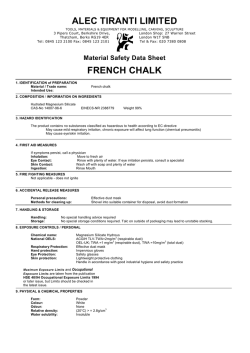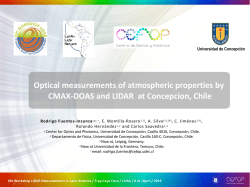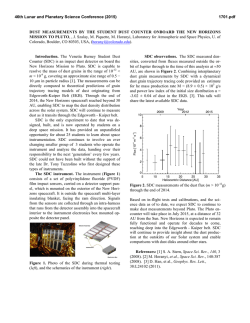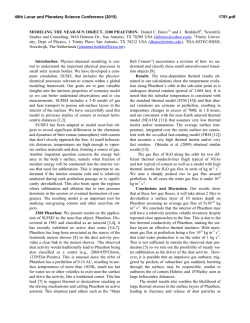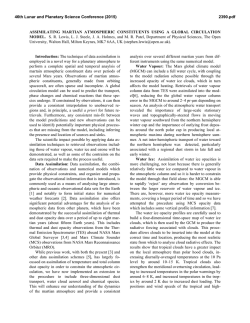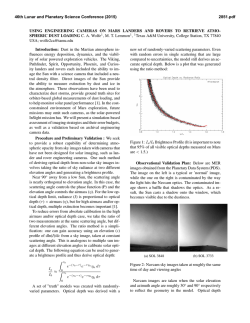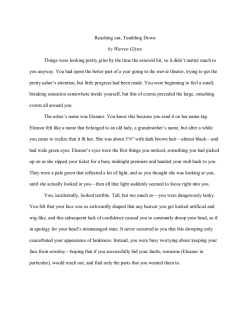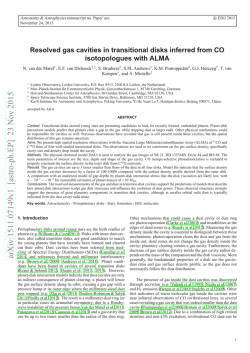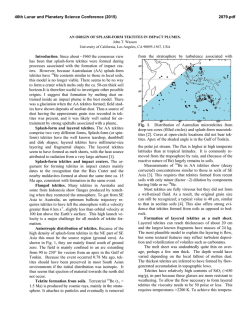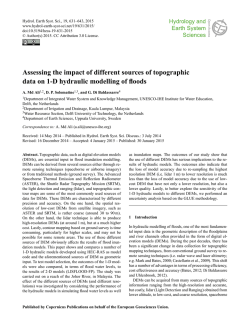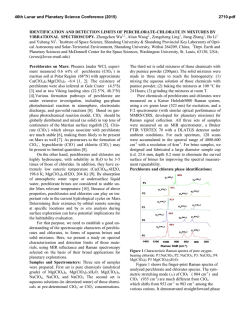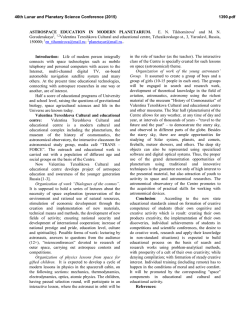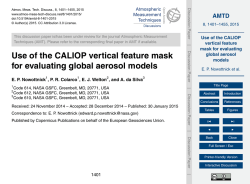
Dust count mode of LIDAR onboard Hayabusa
46th Lunar and Planetary Science Conference (2015) 1863.pdf Dust count mode of LIDAR onboard Hayabusa-2. H. Senshu1, S. Oshigami2, R. Yamada2, M. Kobayashi1, N. Namiki2, T. Mizuno3, and Hayabusa-2 LIDAR science team, 1Planetary Exploration Research Center, Chiba Institute of Technology ([email protected]), 2RISE Project Office, National Astronomical Observatory of Japan, 3 Institute of Space and Astronautical Science, Japan Aerospace Exploration Agency. Introduction: LIDAR (LIght Detection And Ranging) is one of the satellite buses onboard Hayabusa-2. Basically LIDAR is used to measure the distance between the satellite and the target asteroid, 1999JU3. The distance is important information to control the satellite in descending operation such as closeup observation from low altitude and separation of rover, lander, and small carry on impactor. Especially an accurate measurement of the distance is required during touch-down and sampling operations. Thus LIDAR onboard Hayabusa-2 (hereafter we simply represent this instrument as “the LIDAR”) is required to measure about 4 orders of magnitude variety of distance, from 30m to 25km. To satisfy this requirement, the LIDAR has two types of receiver optics, one is for near range (nearer than 1km) and another is for far range (farer than 1km) [1,2]. The distance from the target asteroid, 1999JU3, is one of the fundamental information for operational and scientific observations. For example, the gravitational acceleration is calculated from the change rate of the distance from the target asteroid during free fall operation. Construction of a shape model requires a characteristic length scale in camera image. And also, the measurement of the absolute reflectance from camera image and/or spectrometer data requires an absolute distance from the target [1,2]. The LIDAR can measure absolute reflectance at the wavelength of 1064nm by itself since the LIDAR monitors the energies of the laser pulse and receiving signal. The accuracy of determining the reflectance is so far estimated no better than 25%, but it would become better through further calibration tests using a pre-flight model of the LIDAR [1]. Dust count mode is one of the operational modes of the LIDAR in which the LIDAR detects faint scattered light from dust grains on the line of sight. The distribution of dust grains along the line of sight is estimated from the profile of received light and the effective reflectance of dust cloud. In this presentation we will introduce the function of this mode. Dust count mode: LIDAR is a common instrument in the field of terrestrial atmosphere observation. In this case the energy profile of received light is recorded and by comparison with transmitting laser energy and predicted reflectance of an aerosol the energy profile is transferred to the density distribution of aerosols along the line of sight. On the contrary, in the case of deep space mission, we cannot take the same method with terrestrial atmosphere observation. The profile of received light makes a large data but there is a limitation on the amount of data traffic between the satellite and the Earth. To suppress the data size an observational range is divided into 50 bins and the received energy at each bin is compared with a threshold value. Then we obtain only 50 bits of data for each shot. The minimum length, or duration, of a bin is limited from the response time of the circuit. On the other hand if we set the length of each bins too short, the range of observations became too narrow. We set the duration of each bins to 133.3ns which corresponds to the special resolution of 20m, resulting the total range of observation being 1km (see Fig. 1). The position of an observational range can be changed by delaying the start of observation relative to laser shot. The delay time is set by command from 0 to 126.7us in units of 3.33us which corresponds that the start point of observational range changes from the vicinity of the satellite to 19km far away from the satellite in units of 0.5km. Thus we can search a sign of dust around the target asteroid even from an altitude of 20km (see Fig. 1). However, it is to be noted that the farther the observational range is set, the fainter the signal from dust grains becomes because of geometric attenuation [2]. So we will try to detect dust grains from as low altitude as possible. Fig. 1: Schematic view of dust count mode. Thick curve in the bottom figure represents hypothetical profile of received light. Black-and-white line at the bottom represent an output of dust count mode observation (white=0, black=1). 46th Lunar and Planetary Science Conference (2015) Fig. 2: Schematic view of the results of dust count mode observation with various threshold level (cyan, orange, red, purple and black). Thin curve is an estimated profile of received light. In dust count mode the receiver optics for far range is used. The light energy received by far range optics at an altitude of 1km is estimated about 3 orders magnitude or larger than a nominal noise level. In other words the LIDAR can detect a signal from dust grains even if it is fainter than the scattered light from the surface of the target asteroid by 3 orders of magnitude [2]. True noise level is to be confirmed in space and expected to be lower than the nominal value. One-time observation described above gives us only 50 bits data. So the energy profile of received light cannot be obtained from single shot. To estimate the energy profile of received light multiple shots by changing the threshold is required (see Fig. 2). The LIDAR provides 64 sets of threshold value, from a larger value to be used in normal ranging mode to a much smaller value than the nominal noise level. So we can estimate the energy profile of received light by changing the threshold properly. Function test of dust count mode: Performance of dust count mode was checked by two types of function tests. One is electric test and another is optic test. In the electric test a single electrical pulse is applied directory to the circuit behind the optics to check whether or not the pulse is detected in proper bin. The electric tests were taken place for various bins with Fig.3: A part of output obtained in function test of dust count mode. The output of 50bins for a shot is listed in one line and the series of results are shown line by line. An output of 1 (over the threshold) is represented by hatched pink. In this part of test, the location (timing) of signals are moved far (later) by 500m. 1863.pdf Fig. 4: An example of a series of outputs obtained in function test of dust count mode for various thresholds (red, orange, blue, purple and black). The range (timing) of an output of 1 (above the threshold) is indicated by thick line. Thin black curve represented an estimated profile of input and hatched histogram represents true input profile. various delay time, and showed that the circuit behind the optics works properly in dust count mode, at least for a single pulse. Fig. 3 and 4 show the results from the optic test in which light with a known profile was conducted into the optics to check the timing and the effect of the change of threshold value. These results are almost satisfiable, but additional test by using pre-flight model is needed. Summary: Dust count mode is one of the operational modes of LIDAR onboard Hayabusa-2 in which the LIDAR detects faint scattered light from dust around the target asteroid. Its function was tested both electrically and optically, and it seemed working properly. Acknowledgement: We would like to sincerely thank T. Kase (NEC Corporation) for his assistance in developing and testing the dust count mode of the LIDAR. References: [1] Namiki et al. (2014) 45th LPSC, Abstract #1922. [2] Namiki et al. (2015) 46th LPSC, Abstract. [3] Oshigami et al. (2015) 46th LPSC, Abstract.
© Copyright 2026
